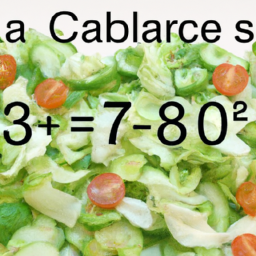Calories in Salad Garden Salad
How Many Calories In A Garden Salad
How Many Calories In A Garden Salad?
Features
A garden salad is a simple, light meal consisting of lettuce, tomatoes, onions and cucumbers. Variations can include shredded carrots, diced peppers, snap peas and other vegetables to make it a healthier and more ingredient-packed meal. Garden salads are a low-calorie food with a range of nutrients and other benefits.
Pros & Benefits
Garden salads offer a variety of health benefits. They are low in fat and are an excellent source of dietary fiber and vitamins A and C, while providing generous amounts of potassium. The health benefits of added nutrient-dense vegetables can be beneficial to weight-loss or weight-control efforts.
A garden salad is a light meal that helps to meet the daily recommended intake of five to nine servings of fruits and vegetables each day. This simple meal also provides additional health benefits such as a lower risk of developing certain chronic diseases and cardiovascular risk-factors.
Case Studies
In a two-year study of adults aged 65 and older, those who ate a garden salad at least four times per week had a lower risk of developing dementia than those who ate it less often.
In a study of children aged 1 to 17, eating a garden salad five times or more per week was associated with lower levels of inflammation, an indicator of a healthy heart.
In a study of adults aged 20 to 50, those who ate a garden salad five or more times per week had higher levels of beneficial omega-3 fatty acids, an indicator of heart health, than those who ate it less often.
FAQ's
Q: What vegetables are in a garden salad?
A: Common vegetables found in garden salads include lettuce, tomatoes, onions, and cucumbers, but variations can include carrots, peppers, snap peas, and other vegetables.
Q: Is a garden salad healthy?
A: Yes, garden salads can be a healthy meal. They are low in fat and provide dietary fiber, vitamins, and minerals. Eating a garden salad five times or more each week has been associated with lower levels of inflammation and higher levels of beneficial fatty acids.
Mistakes People Make
Some people may make the mistake of adding sugary, fatty toppings to their garden salads, like croutons, cheese, bacon, and other high-calorie items. This defeats the purpose of a healthy meal and can easily add hundreds of extra calories.
Another mistake people make is using excessive amounts of salad dressings and sauces. Most dressings and sauces are high in added sugar, as well as unhealthy fats, which can negate the benefits of the garden salad.
Best Practices
The best way to eat a garden salad is to keep it simple. Try to add vegetables that are nutrient-rich and low in unhealthy fats, sugars, and sodium. Opt for natural dressings or light (low-calorie) options, and limit the amount of dressing used.
When it comes to calories, a garden salad is typically very low, around 100-150 calories depending on the type and amount of ingredients used. To make it a more nutrient-rich meal, try adding things like grilled chicken, salmon, or avocado.
Conclusion
A garden salad is a simple, light meal that can help to meet the daily recommended intake of five to nine servings of fruits and vegetables each day. Eating a garden salad can provide numerous health benefits, including a lower risk of developing certain chronic diseases and cardiovascular risk-factors. To ensure that the garden salad remains low in calories and nutrient-dense, it is best to keep it simple and to add lean protein or other sources of healthy fats.

Previous Page
Next Page
